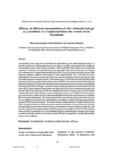Please use this identifier to cite or link to this item:
https://cris.library.msu.ac.zw//handle/11408/638| Title: | Efficacy of different concentrations of aloe chabaudii leaf gel as a substitute for a sulfonamide for the control of avian coccidiosis | Authors: | Sungirai, Marvelous Mucheni, Moses Masaka, Lawrence |
Keywords: | Aloechabaudii, coccidiosis, sulphonamide, efficacy | Issue Date: | 2014 | Publisher: | Midlands State University | Series/Report no.: | Midlands State University Journal of Science Agriculture and Technology;Vol.5 (1); p.33-45 | Abstract: | The objectives of this study were to investigate the effectiveness of Aloe chabaudiiSconland juice as a potential substitute of sulphonamide drugs and to measure its effects when administered at different concentrations in the control of avian coccidiosis. Thirty Cobb 500 broiler chickens were used for the experiment. The broilers were randomised into six groups of five birds each and the groups were assigned to six treatments in a Complete Randomised Design (CRD). Four of the groups were given any one of the following treatments, different concentrations of Aloe (weight/volume: 10%, 20% and 30%) and a sulphonamide. There was a control group which was not given a treatment and one cohort group which was neither infected nor treated (Control). At two weeks of age, 25 of the birds were infected with coccidia via drinking water using infected chicken feacal matter, while the remaining five birds were left uninfected. Infection proceeded for 1 week and after the infection period, feacaloocysts were counted from each individual bird using the McMaster technique. Treatments started one day post infection and continued for one week where after 20 gram samples of feacal matter were taken from each bird per treatment and oocysts were counted. After oocyst counting, all birds were slaughtered and lesion scoring was done on the intestines using the Johnson and Reid technique. Data was analysed for oocysts count in different treatments, feacal egg count reduction, relative risk of coccidiosis and the effectiveness of aloe concentrations as a substitute for a commercial sulphonamide. The results showed that the concentrations of aloe used in the experiment were not effective as compared to the sulphonamide in controlling coccidiosis as the feacal egg reduction was below 90% for all concentrations. The relative risk of coccidiosis infection in the farm was found to be 100% meaning coccidiosis is a disease of economic importance at the farm. However there was a reduction in the feacaloocyst count with increase in aloe juice concentration to control coccidiosis, though this could be not be compared to the sulphonamide used (ESB3) which was more effective (p<0.05). This study has shown that there is potential for use of Aloe chabaudii leaf gel as a chemotherapeutic though much research is needed to determine absolute concentrations which will make it comparable to commercially available drugs in terms of efficacy. | URI: | http://hdl.handle.net/11408/638 |
| Appears in Collections: | Research Papers |
Files in This Item:
| File | Description | Size | Format | |
|---|---|---|---|---|
| efficacy.pdf | 6.45 MB | Adobe PDF |  View/Open |
Page view(s)
178
checked on Jan 20, 2026
Download(s)
64
checked on Jan 20, 2026
Google ScholarTM
Check
Items in MSUIR are protected by copyright, with all rights reserved, unless otherwise indicated.



